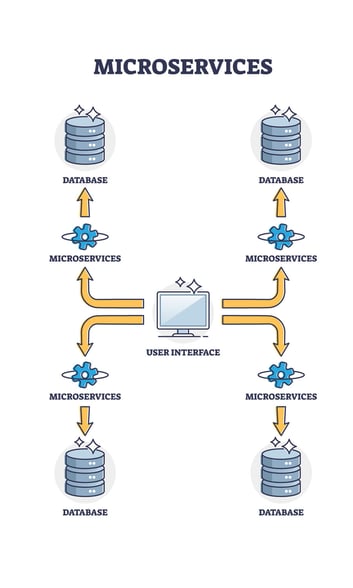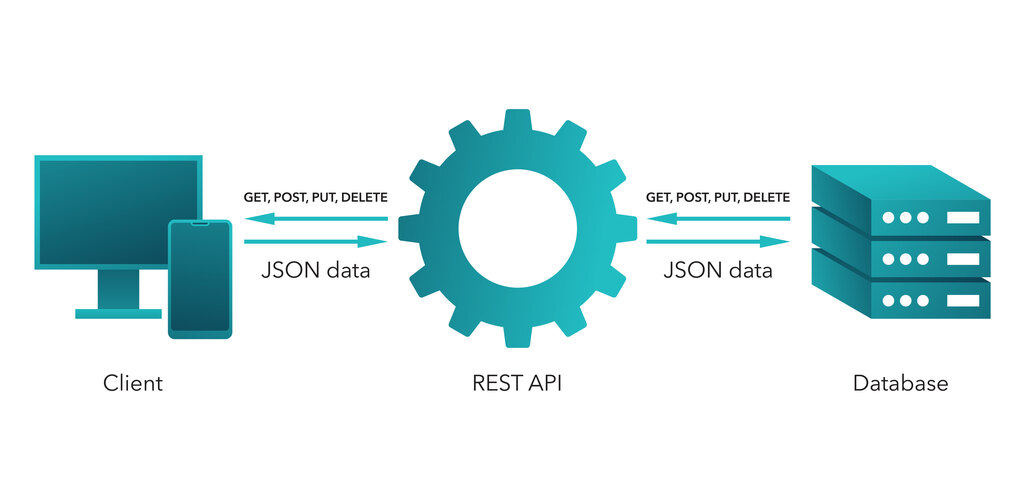Software project development is complex, especially for developers who fail to plan. Engineers must clearly state every vital detail about the software product to ensure the development goes smoothly.
A good software product must meet business requirements and exceed stakeholders' expectations. Also, good software must be reliable, scalable, secure and maintainable, with well-written code that enables easy updates.
But this can only be achieved with a software system architecture that serves as a blueprint for developing the product. In order to understand this better, we need to first define, what software architecture is.
This article explains everything you need to know about software architecture patterns and the characteristics of good software system architecture.
Key Points
- Software architecture defines a software system's overall function and structure, its relationship, and how they interact.
- A good software architecture will describe the system components and spell out which components should and should not be in the system.
- Software architecture design pattern is a reusable solution that enables developers to express and define a structural schema for all software systems.
- Examples of architecture design patterns are layered, microservice, microkernel, event-driven, client-server architecture patterns, etc.
- When creating software architecture, developers need to follow the SOLID principle. SOLID means single responsibility, open close, Liskov substitution, interface segregation and dependency inversion.
Understanding Software Architecture
Most development projects have varied levels of complexity which engineers can manage better by building good software architecture.
To ensure that developers build software products as intended, stakeholders must understand and visualise the project. Software architecture is the step of creating a visual for a project, so stakeholders will know what is involved.
The perfect architectural design will help you deliver the functional requirements of the software to meet business needs. Also, it states the non-functional requirements like scalability, security, performance, testability and maintainability.
Software architecture defines the functions of the software system, which components should be in it, how the different components will interact, and the operating environment.
Aside from that, software architecture defines the overall structure and constraints developers will need to work in and includes charts, diagrams, documentation and anything that can aid communication with stakeholders.
Objectives of Creating Software Architecture
Engineers have the following objectives when creating software architecture:
- To explain the organisation and structure of the software system without diving into implementation details.
- Create a pictorial representation of how the system will meet the functional requirements of the stakeholders.
- To explain how the software will meet non-functional requirements.
- Creating the base or foundation of an information system that fulfils the functional requirements.
Characteristics of Software Architecture
An organised architecture ensures the longevity of the software's internal quality. Some characteristics include the following:
- A Description of the System Setup
Good software system architecture should make it easier for stakeholders involved in making the software to understand the overall system setup.
It should contain visuals, which include diagrams and charts, that show relationships between components and the various subsystems.
Also, visuals should give stakeholders insight and perspective into the design when analysing the structure and looking for ways to improve or expand it.
- Definition of the Fundamental Elements
Another characteristic of architectural software design is defining the core elements and properties needed to build the system. While it does not document every element in detail, it identifies the various structures developers need to build the system's core functionality.
- Description of High-level Structures
The architecture must describe high-level structures to help the development team make decisions about the system's availability, scalability, performance, reliability, maintainability, configuration and support.
- A Description of the Software Product
Describing what you are building outlined in the system architecture will help you manage stakeholders' expectations. Using diagrams and flowcharts to depict the system will help stakeholders be informed and avoid features and work creep.
- Ensures Software Is Up to Standard
Software architectural design makes it easy for engineers to write clean code. Clean source code makes the software product easy to maintain and ensures software testing, enabling faster bug identification.
- Modularity
Modularity is the extent to which a web app/software can be divided into smaller modules. Software architecture makes dividing the system into smaller, more manageable modules during development easy, which helps introduce microservices architecture when scaling up operations.

Principles You Should Keep in Mind When Creating Software Architecture
When creating software architecture, developers need to follow a few principles known as the SOLID principles.
- Single responsibility. In this principle, each module or class in a program should be exclusively responsible for only a single functionality.
- Open-closed. Each component in a system should be open for enhancement without having to modify the components.
- Liskov substitution. It models good inheritance hierarchies. Objects of the subclass should behave the same way as the superclass.
- Interface segregation. Application interfaces are split into smaller and more specific ones to reduce the side effect of using more extensive interfaces. This way, classes won't need to implement irrelevant methods.
- Dependency inversion. Higher-level modules providing complex logic should be easily reusable and unaffected by lower-level modules' changes.
What Is Software Architecture Pattern?
A software architecture design pattern is a reusable solution that allows you to express and define a structural schema for all software systems. The architecture pattern captures the design structures of a software's various systems and components so developers can reuse them.
Also, it helps engineers to address various concerns, such as performance limitations, maintainability and manageability.
Types of Software Architecture Patterns
Examples of architecture patterns are layered, client-server, microkernel, event-driven, microservice pattern, etc.
Layered Pattern
This architecture pattern is n-tiered, with components organised in horizontal layers. In this pattern, all the components are interconnected but don't depend on each other.
This design has four different layers, which include:
- A layer of presentation: the interface where users enter data into the application.
- Commercial layer: handles the execution of business logic in line with the request.
- Application layer: serves as a conduit for information exchange between the presentation and data layers.
- Data layer: manages the data and stores it in the database.
The code is arranged so that data enters the top layer and moves down each layer till it reaches the database at the bottom.
Each layer has separate tasks of checking the data for consistency or reformatting the value to keep it consistent. Since layered architecture enables each layer to focus on a specific task, it makes it the code:
- Maintainable
- Testable
- Easy to update
Also, the layers are isolated, so they are not affected when changes are made to individual layers, allowing for easier refactoring.
The layered architecture pattern is ideal for e-commerce websites and new applications that need to be built quickly.
Event-Driven Pattern
Event-driven architecture is a system design practice built to record, transmit and process events through decoupled architecture. It comprises decoupled, single-purpose event-processing components that asynchronously receive and process events once they are fired.
An excellent example of event-driven architecture is an e-commerce website. The EDA enables the website to react to multiple events at a time of high traffic while preventing the application from crashing.
Some advantages of event-driven architecture are:
- Decoupling - services no longer need to know other services exist to work together, which makes it a natural fit for connecting microservices.
- Scalability - one event can trigger several other actions, enabling parallel task execution and improving performance.
- Real-time workflow - since EDA executes events as they occur, it is possible to support real-time responses to events like purchases and live chat messages.
The architecture pattern is ideal for e-commerce websites and any website built with JavaScript.
Microservices Architecture Pattern

The components are separated into units in microservices through a practical, streamlined delivery pipeline. It is an alternative to monolithic applications because it is highly scalable and has a high degree of decoupling.
In this architecture pattern, the components can be separately developed, deployed and tested without interdependency on any other components.
Netflix is an example of a website that uses the microservice architecture pattern. The pattern allows the engineers to work in small batches and be responsible for the end-to-end development of hundreds of microservices that stream digital entertainment to Netflix customers daily.
Microservice architecture is ideal for businesses and web apps needing rapid development. Also, it is perfect for websites with small components.
Client-Server Architecture Pattern

This architecture design has two main components - client and server. Client-server architecture facilitates the communication between the server and the client, which may or may not be on the same network.
When a client requests a specific resource which might be in the form of data, the server identifies the request and responds by sending the resource.
This software architecture design pattern is highly flexible because a single server can serve different clients, and a single client can make requests from multiple servers.
Email is an example of a model built using the client-server architecture pattern. When a user requests a particular email, the server looks into the resource and returns the requested email.
It is ideal for email, network printing, file-sharing, and online banking applications. Also, it is perfect for applications with centralised resources that have to be distributed over multiple servers.
MicroKernel Architecture Pattern
This pattern has two components - the core system and plug-ins which allows programmers to add additional application features with plug-ins to the core system.
One advantage of the microkernel architecture is the ease of deployment. Depending on how the pattern is implemented, plug-ins can be added dynamically to the core system at runtime to minimise downtime during deployment.
Microkernel architecture is ideal for applications with a fixed set of core routines and dynamic rules requiring frequent updates.
An example is Eclipse IDE. When you download the product, you have nothing but a fancy editor, but when you add plug-ins, it becomes useful for development.
Internet browsers like Firefox and Chrome are other examples of software that use the microkernel architecture because they support extensions that can add additional features to the browser.
Spaced-Based Architecture
Also known as the cloud architecture pattern, the space-based pattern reduces the factors that limit application scaling.
In this architectural design, the various components interact with each other by exchanging tuples via one or more shared spaces. High scalability is achieved with the central database constraints removed and by using replicated in-memory data grids instead.
There are two components in this architecture pattern - processing unit and virtualised middleware.
The processing unit contains the application modules, an in-memory data grid and a replication engine to reproduce data changes made by one processing unit to another active process.
In contrast, the virtualised middleware contains components that control data synchronisation and request handling.
This architecture pattern is ideal for applications and software that function with a large user base and a constant load of requests.
What Are the Benefits of Creating Software Architecture?
The following advantages make it worthwhile to create the architecture of the software.
- Architecture can create prototypes of the application system easily.
- With architecture, you can manage software better and add new updates.
- It provides a clear understanding of the proposed software system to all stakeholders, increasing your chance of success.
- Software architecture can make development cost-effective when created effectively.
Looking for reliable developers? Book a call with Deazy today and let our experts put together the perfect development team for you.
Frequently Asked Questions
Why Do I Need Software Architecture?
Software architecture reduces the complexity of a software system and prevents developers from making incorrect decisions. Also, the software architecture provides a basis for communication across all stakeholders and helps ensure the software's internal quality's longevity.
What Are the Differences between Software Architecture and Design?
Software design deals with individual modules and components of the software, while software architecture deals with the system's overall structure. While architecture describes what to do, design illustrates how to do things.
What Are the Importance of Software Architecture Patterns?
Software architecture pattern is a reusable solution to commonly occurring problems in software development. The patterns allow developers to achieve higher levels of quality while still maintaining efficiency. Software architecture patterns are similar to design patterns but have a higher scope.
What Are the Components of Software Architecture?
Software architecture considers the critical stuff like the structural elements and their interfaces, the behaviour and interaction between those elements. Also, the composition of the elements within the system, how the architecture decision meets business objectives and customer's expectations.
